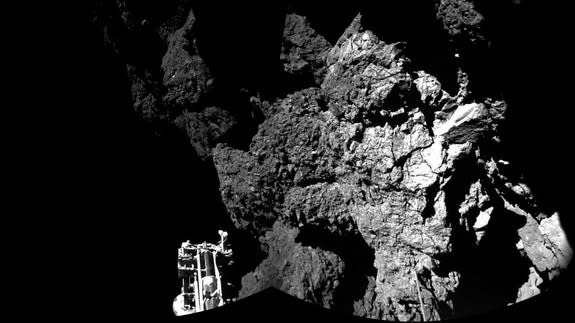Bye, Philae: Scientists give up hope for comet lander

Europe's Philae lander, a washing machine-sized robot that captured the imagination of the world when it landed on a comet, has likely entered its "eternal hibernation," the European Space Agency (ESA) confirmed Friday.
The spacecraft was a little more than one year old, and passed away after a long and courageous battle against darkness.
“The chances for Philae to contact our team at our lander control centre are unfortunately getting close to zero,” said Stephan Ulamec, Philae project manager, in a statement.
“We are not sending commands anymore and it would be very surprising if we were to receive a signal again.”
SEE ALSO: Wake up, Philae. You're on a comet headed for the Sun.
Philae landed on Comet 67P on Nov. 12, 2014, bouncing its way into history as the first human-made spacecraft to touchdown softly on a comet.
However, after people on Earth celebrated the deep space landing, it quickly became clear that not all was well.
The spacecraft made a couple of hard bounces on 67P before finally settling in at a shady part of the comet, where it couldn't quite get enough sun to keep its battery charged.
In spite of its unfortunate circumstances, the lander was still able to beam back science from the comet's surface for hours after it touched down.
Philae sent images of its landing spot and even managed to find organic compounds on the comet.
Then, it went silent.
Many people thought that was the end of Philae's short and historic life, but suddenly, in June, Rosetta got a ping from the lander that it relayed back to Earth, renewing hope for its resurrection.

Image: ESA/Rosetta/MPS
But alas, that hope was short-lived.
Philae got in touch with Rosetta seven more times after that burst of communication in June, with its final ping sent on July 9.
Scientists were still hopeful that Philae would get in touch again as the comet warmed up a bit while it made its way to its closest pass with the sun in August, but the lander didn't send anything through.
"The mission engineers think that failures of Philae’s transmitters and receivers are the most likely explanation for the irregular contacts last year, followed by continued silence into this year," the ESA said.
Philae is survived by its mothership, Rosetta. The orbiter will likely join Philae on 67P at the end of its mission in September, reuniting the two spacecraft on the surface of the comet they both studied.
In the meantime, Rosetta will still keep a listen out for Philae's pings, but scientists don't think that the little lander will get in touch again.
"We would be very surprised to hear from Philae again after so long, but we will keep Rosetta’s listening channel on until it is no longer possible due to power constraints as we move ever further from the sun towards the end of the mission," Patrick Martin, ESA’s Rosetta mission manager, said in the statement.


